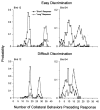Watching the clock
- PMID: 19701487
- PMCID: PMC2729517
- DOI: 10.1016/S0376-6357(98)00050-3
Watching the clock
Abstract
Four rats and four pigeons were monitored while performing retrospective timing tasks. All animals displayed collateral behaviors which could have mediated their temporal judgements. Statistical analysis made a good case for such mediation in the case of two pigeons performing on a spatially-differentiated response, but not for the two responding on a color-differentiated response. For the rats, all of which performed on a spatially-differentiated task, prediction of their temporal judgements was always better if based on collateral activity than if based on the passage of time.
Figures



Similar articles
-
The effect of alcohol administration on human timing: a comparison of prospective timing, retrospective timing and passage of time judgements.Acta Psychol (Amst). 2011 Sep;138(1):254-62. doi: 10.1016/j.actpsy.2011.07.002. Epub 2011 Jul 29. Acta Psychol (Amst). 2011. PMID: 21802649 Clinical Trial.
-
I can time with a little help from my friends: effect of social enrichment on timing processes in Pigeons (Columba livia).Anim Cogn. 2016 Nov;19(6):1205-1213. doi: 10.1007/s10071-016-1032-z. Epub 2016 Sep 8. Anim Cogn. 2016. PMID: 27632157
-
Discrimination of temporal relations by pigeons.J Exp Psychol Anim Behav Process. 1988 Oct;14(4):349-67. J Exp Psychol Anim Behav Process. 1988. PMID: 3183576
-
Prospective and retrospective timing in mild cognitive impairment and Alzheimer's disease patients: A systematic review and meta-analysis.Behav Brain Res. 2021 Jul 23;410:113354. doi: 10.1016/j.bbr.2021.113354. Epub 2021 May 11. Behav Brain Res. 2021. PMID: 33989726
-
Folic acid supplementation and malaria susceptibility and severity among people taking antifolate antimalarial drugs in endemic areas.Cochrane Database Syst Rev. 2022 Feb 1;2(2022):CD014217. doi: 10.1002/14651858.CD014217. Cochrane Database Syst Rev. 2022. PMID: 36321557 Free PMC article.
Cited by
-
Searching for the holy grail: temporally informative firing patterns in the rat.Adv Exp Med Biol. 2014;829:209-34. doi: 10.1007/978-1-4939-1782-2_12. Adv Exp Med Biol. 2014. PMID: 25358713 Free PMC article. Review.
-
A computational formulation of the behavior systems account of the temporal organization of motivated behavior.Behav Processes. 2019 Dec;169:103952. doi: 10.1016/j.beproc.2019.103952. Epub 2019 Sep 20. Behav Processes. 2019. PMID: 31543283 Free PMC article. Review.
-
Learning to Time: a perspective.J Exp Anal Behav. 2009 Nov;92(3):423-58. doi: 10.1901/jeab.2009.92-423. J Exp Anal Behav. 2009. PMID: 20514171 Free PMC article. Review.
-
Prospective and retrospective timing by pigeons.Learn Behav. 2010 May;38(2):119-25. doi: 10.3758/LB.38.2.119. Learn Behav. 2010. PMID: 20400732
-
About Skinner and time: behavior-analytic contributions to research on animal timing.J Exp Anal Behav. 2006 Jan;85(1):125-42. doi: 10.1901/jeab.2006.85.04. J Exp Anal Behav. 2006. PMID: 16602380 Free PMC article. Review.
References
-
- Bakeman R, Quera V. Analyzing Interaction: Sequential Analysis with SDIS and GSEQ. Cambridge University Press; Cambridge: 1995. p. 155.
-
- Bakeman R, Quera V, McArthur D, Robinson BF. Detecting sequential patterns and determining their reliability with fallible observers. Psych Meth. 1997;2:357–370.
-
- Beam JJ, Killeen PR, Bizo LA, Fetterman JG. The role of reinforcement context in temporal production and categorization. Anim Learn Behav. 1998 in press.
-
- Bem DJ. Beliefs, Attitudes, and Human Affairs. Brooks/Cole; Belmont, CA: 1970.
Grants and funding
LinkOut - more resources
Full Text Sources

